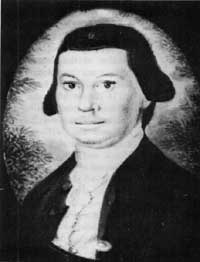







Biographical Sketches
|
JOHN MORTON Pennsylvania |
 John Morton | |
| ||
Morton was born of Finnish-Swedish descent in 1725, shortly after the death of his father, on a farm in Ridley Township, Chester (present Delaware) County. John Sketchley, an Englishman who subsequently married the widowed mother of the youth, reared and educated him. Their relationship was apparently close, for Morton later named his eldest son Sketchley. The stepfather, learned in mathematics, taught the boy the three R's as well as surveying. He practiced that profession on and off all his life, as well as farming, politics, and jurisprudence. He married in his early 20's, in 1748 or 1749, and fathered five daughters and four sons.
At the age of 30, Morton entered politics, which from then on absorbed most of his energies. From 1756 until a few months before he died in 1777, he served 18 terms in the colonial/State legislature (1756-66 and 1769-76), which he presided over during the last year and a half. In 1774 he won appointment as an associate justice of the Pennsylvania Supreme Court.
Meantime, despite his rise in State circles, Morton had always maintained strong ties with his own county. He resided there all his life, remained active in civic and church affairs, and stayed close to the people. Between terms of office as county justice of the peace (1757-64 and 1770-74), he worked in a tour as sheriff (1766-69).
Morton's service to the Nation began in 1765, while he was a member of the Pennsylvania legislature. He and two colleagues represented the colony at the Stamp Act Congress in New York. His most dramatic act as Delegate to the Continental Congress (1774-77), in which he numbered among the moderates, was his sudden and crucial switch on July 1, 1776, to the side of his friend Benjamin Franklin and James Wilson in the vote for national independence. On the final vote the next day, these three ballots outweighed those of Thomas Willing and Charles Humphreys. Robert Morris and John Dickinson being purposely absent, Pennsylvania registered a "yea." Less glamorously, Morton was a member of many committees, in 1777 chairing the committee of the whole on the adoption of the Articles of Confederation, finally ratified after his death.
Within a year of signing the Declaration, in the spring of 1777, Morton fell ill and died on his farm at the age of 51. A few months earlier, he had bequeathed his land and property, including a few slaves, to his wife and five daughters and three surviving sons. But he could not will them security; shortly after his demise they had to flee from their home in the face of an imminent British attack. Morton's grave is located in Old St. Paul's Cemetery in Chester, Pa.
Drawing: Watercolor, ca. 1765, by Pierre Eugene Du Simitàre, The R. W. Norton Art Gallery, Shreveport, La.
 |
 |
http://www.cr.nps.gov/history/online_books/declaration/bio34.htm
Last Updated: 04-Jul-2004